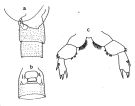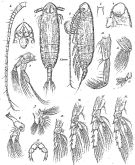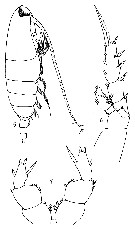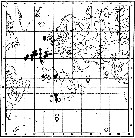|
|
 |
|
Calanoida ( Order ) |
|
|
|
Clausocalanoidea ( Superfamily ) |
|
|
|
Phaennidae ( Family ) |
|
|
|
Cephalophanes ( Genus ) |
|
|
| |
Cephalophanes refulgens Sars, 1907 (F,M) | |
| | | | | | | Syn.: | ? Cephalophanes tectus : Grice, 1969 a (p.453);
Cephalophanes frigidus : Tanaka, 1960 a (p.124, figs.F, juv.F) | | | | Ref.: | | | Sars, 1907 a (p15); 1925 (p.154, figs.F); Farran, 1908 b (p.49, figs.F); 1926 (p.268); Steuer, 1926 (p.182, figs.F,M); Rose, 1933 a (p.141, figs.F); Lysholm & al., 1945 (p.26); Marques, 1953 (p.103, fig.F); Vervoort, 1965 (p.34, Rem.); Park, 1983 a (p.321, 324, Rem.); Tanaka & Omori, 1992 (p.254, figs.F); Chihara & Murano, 1997 (p.852, Pl.139: F); Nishida & al., 2002 (p.158, tab.1, figs.F); Boxshall & Halsey, 2004 (p.159, fig.F); Vives & Shmeleva, 2007 (p.680, figs.F, Rem.) |  issued from : O. Tanaka & M. Omori in Publs Seto Mar. Biol. Lab., 1992, 35 (4/5). [p.255, Fig.1, a-c]. Female: a, last thoracic segment and 1st and 2nd urosomal segments (lateral left side); b, genital segment (ventral); c, P5. Nota: A1 extends to caudal ramus.
|
 Issued from : G.O. Sars in Résult. Camp. Scient. Prince Albert I, 69, pls.1-127 (1924). [Pl.XLIII, figs.1-17]. Female (from NE temperate Atlantic and W Mediterranean Sea): 1, habitus (dorsal); 2, idem (lateral left side); 3, forehead (dorsal); 4, idem (lateral); 5, rostral filaments; 6, A1; 7, A2; 8, Md; 9, Mx1; 10, Mx1; 11, distal part of Mx1 bud-like setae (enlarged); 12, Mxp; 13, P1; 14, P2; 15, P3; 16, P4; 17, P5. Female (after Sars, 1924-1925) :
- Cephalosome and pedigerous somite 1 with suture more or less visible, pedigers 4 and 5 separate - Anterior part of Cephalosome with a voluminous luminous apparatus - Rostrum absent except 2 thin distinct filaments. - Posterior corners of last thoracic segment like triangular shape. - Urosome 4-segmented ; about ¼ the length of prosome. - Genital segment slightly swollen ventrally, length as long as the two suceeding segments ; - Anal segment short. - Caudal rami short, symmetrical, slightly longer than wide. - A1 24-segmented, length exceeding urosome by some segments. - A2 buramous ; coxa with 1 seta ; basis with 2 setae ; exopod, thick and about 2 times the length of endopod ; - Md with a large gnathobase, teeth ointed and bifid ; palp biramous, basis with 3 setae, rami with 2-segmented endopode and 4-segmented exopod. - Mx2 with distal endite bearing 2 apical setae strong and spiniform ; distal part bearing a thin apical seta and 6 short sensitiform elements (brush-like) of the same structure than in Xanthocalanus. - Mxp with coxa and basis long and of the same length ; endopod 5-segmented bearing inner setae of moderate lengrh. - Swimming legs P1 to P4 biramous. - Endopodal segments 2 and 3 of P2 and P3 with outer spines ; only on the 2 nd segment in P4. - P5 uniramous, slightly curved ; each ramus 3-segmented ; coxa the larger with denticles on the inner margin, basis with 1 denticle and slightly pilose, distal segment of the same length than the preceeding, narrower and with 4 spines (2 at apex, and 2 lateral, the inner longer than other spines).
Male (after Rose, 1933 a, p.140):
- P5 asymmetrical ; left larger, 4-segmented ; distal segment ending in 2 small teeth and bears 3 teeth on yje inner margin ; right leg with 3 or 4-segmented (1st and 2 nd segments badly separate) ; distal segment with 2 terminal teeth and 1 innner.
|
 issued from : A. Steuer in Wiss. Ergebn. dt. Tiefsee-Exped. \"Valdivia\", 1926, 23. [p.182, Figs.1-4]. Female: 1, habitus (dorsal); 2, P5; 3, last thoracic segment and urosome segment 1; 4, posterior thoracic segment and urosome (lateral; individual from another station).
|
 issued from : A. Steuer in Wiss. Ergebn. dt. Tiefsee-Exped. \"Valdivia\", 1926, 23. [p.183, Figs.5-7]. Male: 5, habitus (dorsal); 6, posterior part of thorax with P5 and urosome (lateral); 7, P5.
|
 issued from : G.P. Farran in Fish. Ire. Sci. Invest., 1906, II [1908]. [Pl. V, Figs.5-7]. Female (from W Ireland): 5, habitus (lateral); 6, P2; 7, P5.
|
 Issued from : O. Tanaka in Spec. Publs. Seto mar. biol. Lab., 10, 1960 [p.125, Fig.100 ]. As Cephalophanes frigidus. Female (from Sagami Bay, Japan): d, last thoracic segment and genital segment; e, P5. Nota: Head and 1st thoracic segment separate, 4th and 5th separate. forehead with a pair of iridescent eyes. Rostral filaments slender. The lateral distal corner of the last thoracic segment rounded with a blunt process on the postero-distal margin. The abdominal segments and furca in the proportional lengths 38 : 23 : 19 : 10 : 10 = 100. Genital segment not produced below. Exopodite of A2 about 1.4 times as long as the endopodite (31 : 23). Mx1 with 9 setae on the outer lobe, 10 setae on exopodite, 3+1+2 setae on endopodite, 5 setae on the 2nd basal, 3 setae on the 2nd basal, 3 setae on the 3rd inner lobe, 2 setae on the 2nd inner lobe, 13 setae on the 1st inner lobe. Mx2: with 8 sensory appendages on endopod (of which the distal one is long and slender, the remainings are bud-like; the spine on the 5th lobe not so strong. P5 3-segmented. 1st segment robust, produced inwardly, with a row of long hair-like spines (about 15 in number) on the inner margin; 2nd segment, also robust, with small denticles on the inner margin about the middle of the segment. Right leg has, beside these marginal denticles several small spines near the distal margin on the posterior surface. The 3rd segment has 2 apical spines and 2 marginal spines, of which the inner marginal one is longer; the posterior surface of the segment has 2 small spines on the right leg, but these spines are absent in the left leg. These posterior spines are more in number in Steueur's example, whereas Farran's specimen has only a single large spine instead of a group of small ones on the posterior surface of the 3rd segment of the right P5. Immature Female (stage V): a, habitus (dorsal); b, forehead (lateral); c, last thoracic segment and urosome (lateral left side). Immature Female: a, habitus (dorsal); b, forehead (lateral); c, last thoracic segment and abdomen (lateral).
|
 Issued from : O. Tanaka in Spec. Publs. Seto mar. biol. Lab., 10, 1960 [p.125]. As Cephalophanes frigidus. Female: Proportional lengths of segments of A1. Nota: A1 24-segmented, exceeds the distal margin of the furca by terminal 2 segments. Segments 8 and 9 fused. Total length 4.8 mm.
| | | | | Compl. Ref.: | | | C.B. Wilson, 1950 (p.188, ? non Pacif.); Grice, 1963 a (p.495); Roe, 1972 (p.277, tabl.1, tabl.2); Deevey & Brooks, 1977 (p.256, tab.2, Station "S"); Vives, 1982 (p.292); Lozano Soldevilla & al., 1988 (p.58); Lapernat, 2000 (tabl.3, 4); Holmes, 2001 (p.55); Gaard & al., 2008 (p.59, Table 1, N Mid-Atlantic Ridge) | | | | NZ: | 6 | | |
|
Distribution map of Cephalophanes refulgens by geographical zones
|
| | |  Chart of 1996 Chart of 1996 | |
 issued from : A. Steuer in Wiss. Ergebn. dt. Tiefsee-Exped. \"Valdivia\", 1926, 23. [p.186, Fig.18]. issued from : A. Steuer in Wiss. Ergebn. dt. Tiefsee-Exped. \"Valdivia\", 1926, 23. [p.186, Fig.18].
Geograpphic distribution of cephalophanes frigidus (white circle, male and female indicated) and C. refulgens (black circle; male and female indicated). |
| | | | Loc: | | | Angola, SE Atlant., G. of Guinea, off NW Cae Verde Is., off Morocco-Mauritania, Canary Is., off Portugal, off Bermuda: Station "S" (32°10'N, 64°30'W), Azores, Bay of Biscay, off W Ireland, off S Iceland, off Bermuda, NW Atlant., Japan (Izu region), ? W Pacif. (off Philippines, Indonesia, Australia) | | | | N: | 19 | | | | Lg.: | | | (1) F: 5,2; (4) F: 4,75; (16) F: 4,13-4; (35) F: 4,32; (38) F: 4,2; (42) F: 4,5-4,2; M: 3,2; (75) F: 4,03; (199) F: 4,2-4,1; M: 3,2-3,04; (866) F: 3,9-4,2; M: 3-4; (867) F: 4,16-4,9; (911) F: 4,15-5,3; {F: 3,90-5,30; M: 3,00-4,00} | | | | Rem.: | Bathypelagic. Sargasso Sea: 500-1500 m (Deevey & Brooks, 1977, station "S");
Vervoort (1965, p.35) raises reservations about the locality records given by C.B. Wilson (1950) in the Pacific (Japan, Bering Sea, off W. Galapagos, off Peru).
Certain confusions seem to exist between this species and C. frigidus.
For Vervoort (1965, p.35), Sars (1925) erroneously gives as the length of the adult female 5.2 mm (but I don't see the reason of this error; C.R.). | | | Last update : 20/02/2017 | |
|
|
 Any use of this site for a publication will be mentioned with the following reference : Any use of this site for a publication will be mentioned with the following reference :
Razouls C., Desreumaux N., Kouwenberg J. and de Bovée F., 2005-2025. - Biodiversity of Marine Planktonic Copepods (morphology, geographical distribution and biological data). Sorbonne University, CNRS. Available at http://copepodes.obs-banyuls.fr/en [Accessed August 17, 2025] © copyright 2005-2025 Sorbonne University, CNRS
|
|
 |
 |










